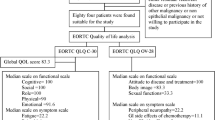Abstract
Goals of work
Quality of life (Qol) represents a relevant end point in the clinical management of advanced ovarian cancer (AOC). However, there exist only a few specific instruments which have been designed for patients with ovarian cancer. The aim of this study was to develop a systematic checklist (Berlin Symptom Checklist Ovary (BSCL-O)) as an instrument of Qol for patients with AOC and to discriminate between the frequency and the importance of symptoms.
Patients and methods
The main symptoms were identified in a phase I study via free interviews of five patients with ovarian cancer (OC) as well as five medical doctors, family dependants, and care workers. In the phase II study, the capability of BSCL-O was evaluated by questionnaire-guided interviews of 200 patients with primary OC, recurrent OC, metastasized breast cancer, and benign ovarian tumors.
Main results
In phase I, 36 main symptoms were identified. In phase II, 7,200 answers from 98.5% of all patients were evaluable. Of the 36 symptoms of the BSCL-O, 23 revealed clinical relevance. There was a correlation of frequency and importance of symptoms (p < 0.05). The symptoms of the BSCL-O were deemed twice as strenuous in patients with recurrent OC.
Conclusions
The BSCL-O can measure Qol of patients with OC. The BSCL-O is being validated in a phase III study.





Similar content being viewed by others
References
Anderson B (1994) Quality of life in progressive ovarian cancer. Gynecol Oncol 55:151–155
Basen-Engquist K, Bodurka-Bevers D, Fitzgerald MA et al (2001) Reliability and validity of the functional assessment of cancer therapy-ovarian. J Clin Oncol 19(6):1809–1817
Bullinger M (1996) Methoden zur Lebensqualitätsbewertung in der Onkologie. Forum Deutsche Krebsgesellschaft 11:210–216
Calhoun EA, Welshman EE, Chang CH et al (2003) Psychometric evaluation of the Functional Assessment of Cancer Therapy/Gynecologic Oncology Group-Neurotoxicity (Fact/GOG-Ntx) questionnaire for patients receiving systemic chemotherapy. Int J Gynecol Cancer 13(6):741–748
Cella DF, Tulsky DS, Gray G et al (1993) The functional assessment of cancer therapy scale: development and validation of the general measure. J Clin Oncol 11:570–579
Coates A, Dillenbeck CF, McNeil DR et al (1983) On the receiving end-II. Linear analogue self-assessment (LASA) in evaluation of aspects of the quality of life of cancer patients receiving therapy. Eur J Cancer Clin Oncol 19:1633–1637
Cull A, Howat S, Greimel E et al (2001) Development of a European organization for research and treatment of cancer questionnaire module to assess the quality of life of ovarian cancer patients in clinical trials: a progress report. Eur J Cancer 37:47–53
Ersek M, Ferrell B, Dow K et al (1997) Quality of life in women with ovarian cancer. West J Nurs Res 19:334–350
Fish L, Lewis B (1999) Quality of life issues in the management of ovarian cancer. Semin Oncol 26:32–39
Greimel ER, Bjelic-Radisic V, Pfisterer J et al (2006) Randomized study of the Arbeitsgemeinschaft Gynaekologische Onkologie Ovarian Cancer Study Group comparing quality of life in patients with ovarian cancer treated with cisplatin/paclitaxel versus carboplatin/paclitaxel. J Clin Oncol 24(4):579–586
Greimel E, Bottomley A, Cull A et al (2003) An international field study of the reliability and validity of a disease-specific questionnaire module (the QLQ-OV28) in assessing the quality of life of patients with ovarian cancer. Eur J Cancer 39:1402–1408
Guidozzi F (1993) Living with ovarian cancer. Gynecol Oncol 50:202–207
Jacobs I, van Nagell J, DePriest P Jr (1998) Screening for epithelial ovarian cancer. In: David M, Gershenson W, Mcguire P (eds) Ovarian cancer: controversies in management. Medical Division of Pearson Professional Limited, New York, pp 1–15
Le T, Leis A, Pahwa P et al (2004) Quality of life evaluations of caregivers of ovarian cancer patients during chemotherapy treatment. J Obstet Gynaecol Can 26(7):627–631
Montazeri A, McEwen J, Gillis C (1996) Quality of life in patients with ovarian cancer: current state of research. Support Care Cancer 4:169–179
Moore DH (1994) Ovarian cancer in the elderly patient. Oncology (Williston Park) 8:21–30
Oskay-Ozcelik G, Sehouli J (2009) Pros and cons for systemic therapy in recurrent ovarian cancer. Anticancer Res 29(7):2831–2836
Portenoy R, Kornblith A, Wong G (1994) Pain in ovarian cancer patients. Cancer 74:907–915
Portenoy R, Thaler H, Kornblith A (1994) The memorial symptom assessment scale: an instrument for the evaluation of symptom prevalence, characteristics and distress. Eur J Cancer 30A:1326–1336
Sun CC, Bodurka DC, Weaver CB et al (2005) Rankings and symptom assessments of side effects from chemotherapy: insights from experienced patients with ovarian cancer. Support Care Cancer 13:219–227
Wenzel L, Huang HQ, Monk BJ et al (2005) Quality-of-life comparisons in a randomized trial of interval secondary cytoreduction in advanced ovarian carcinoma: a Gynecologic Oncology Group study. J Clin Oncol 23(24):5605–5612
Willemse P, van Lith J, Mulder N (1990) Risk and benefits of cisplatin in ovarian cancer. A quality-adjusted survival analysis. Eur J Cancer 26:345–352
Acknowledgements
We wish to thank the patients, their family dependants, the medical doctors, and the care workers who participated in this trial. Without their enthusiastic collaboration, this work would not have been possible.
Author information
Authors and Affiliations
Consortia
Corresponding author
Rights and permissions
About this article
Cite this article
Koensgen, D., Oskay-Oezcelik, G., Katsares, I. et al. Development of the Berlin Symptom Checklist Ovary (BSCL-O) for the measurement of quality of life of patients with primary and recurrent ovarian cancer: results of a phase I and II study. Support Care Cancer 18, 931–942 (2010). https://doi.org/10.1007/s00520-009-0733-0
Received:
Accepted:
Published:
Issue Date:
DOI: https://doi.org/10.1007/s00520-009-0733-0




